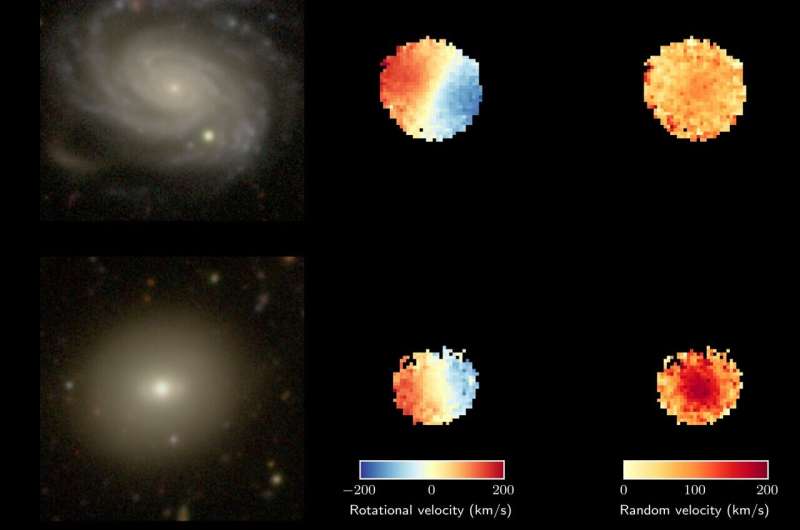This article has been reviewed according to Science X's editorial process and policies. Editors have highlighted the following attributes while ensuring the content's credibility:
fact-checked
peer-reviewed publication
proofread
Study reports that age is the driving force in changing how stars move within galaxies

Galaxies start life with their stars rotating in an orderly pattern but in some the motion of stars is more random. Until now, scientists have been uncertain about what causes this—possibly the surrounding environment or the mass of the galaxy itself.
A new study, published in MNRAS (Monthly Notices of the Royal Astronomical Society), has found that the most important factor is neither of these things. It shows the tendency of the stars to have random motion is driven mostly by the age of the galaxy—things just get messy over time.
"When we did the analysis, we found that age, consistently, whichever way we slice or dice it, is always the most important parameter," says first author Prof Scott Croom, an ASTRO 3D researcher at the University of Sydney.
"Once you account for age, there is essentially no environmental trend, and it's similar for mass.
"If you find a young galaxy it will be rotating, whatever environment it is in, and if you find an old galaxy, it will have more random orbits, whether it's in a dense environment or a void."
The research team also included scientists from Macquarie University, Swinburne University of Technology, the University of Western Australia, the Australian National University, the University of New South Wales, the University of Cambridge, the University of Queensland, and Yonsei University in the Republic of Korea.
The study updates our understanding from previous studies that have variously suggested environment or mass as more important factors. But the earlier work is not necessarily incorrect, says second author Dr. Jesse van de Sande.
Young galaxies are star-forming super-factories, while in older ones, star formation ceases.
"We do know that age is affected by environment. If a galaxy falls into a dense environment, it will tend to shut down the star formation. So galaxies in denser environments are, on average, older," Dr. van de Sande says.
"The point of our analysis is that it's not living in dense environments that reduces their spin, it's the fact that they're older."
Our own galaxy, the Milky Way, still has a thin star forming disk, so is still considered a high spin rotational galaxy.
"But when we look at the Milky Way in detail, we do see something called the Milky Way thick disk. It's not dominant, in terms of light, but it is there and those look to be older stars, which may well have been heated from the thin disk at earlier times, or born with more turbulent motion in the early universe," Prof Croom says.
The research used data from observations made under the SAMI Galaxy Survey. The SAMI instrument was built in 2012 by the University of Sydney and the Anglo-Australian Observatory (now Astralis). SAMI uses the Anglo-Australian Telescope, at Siding Spring Observatory, near Coonabarabran, New South Wales. It has surveyed 3,000 galaxies across a large range of environments.
The study allows astronomers to rule out many processes when trying to understand galaxy formation and so fine-tune models of how the universe has developed.
The next steps will be to develop simulations of galaxy evolution with more granular detail.
"One of the challenges of getting simulations right is the high resolution you need in to predict what's going on. Typical current simulations are based on particles which have the mass of maybe 100,000 stars and you can't resolve small-scale structures in galaxy disks," Prof. Croom says.
The Hector Galaxy Survey will help Prof Croom and his team expand this work using a new instrument on the Anglo-Australian Telescope.
"Hector is observing 15,000 galaxies but with higher spectral resolution, allowing the age and spin of galaxies to be measured even in much lower mass galaxies and with more detailed environmental information," says Professor Julia Bryant, lead of the Hector Galaxy Survey, University of Sydney.
Professor Emma Ryan-Weber, Director of ASTRO 3D, says, "These findings answer one of the key questions posed by ASTRO 3D: how does mass and angular momentum evolve in the universe? This careful work by the SAMI team reveals that the age of a galaxy determines how the stars orbit. This critical piece of information contributes to a clearer big-picture view of the universe."
More information: Scott Croom et al, The SAMI Galaxy Survey: galaxy spin is more strongly correlated with stellar population age than mass or environment, Monthly Notices of the Royal Astronomical Society (2024). DOI: 10.1093/mnras/stae458. academic.oup.com/mnras/article … 0.1093/mnras/stae458
Journal information: Monthly Notices of the Royal Astronomical Society
Provided by ARC Centre of Excellence for All Sky Astrophysics in 3D (ASTRO 3D)



















